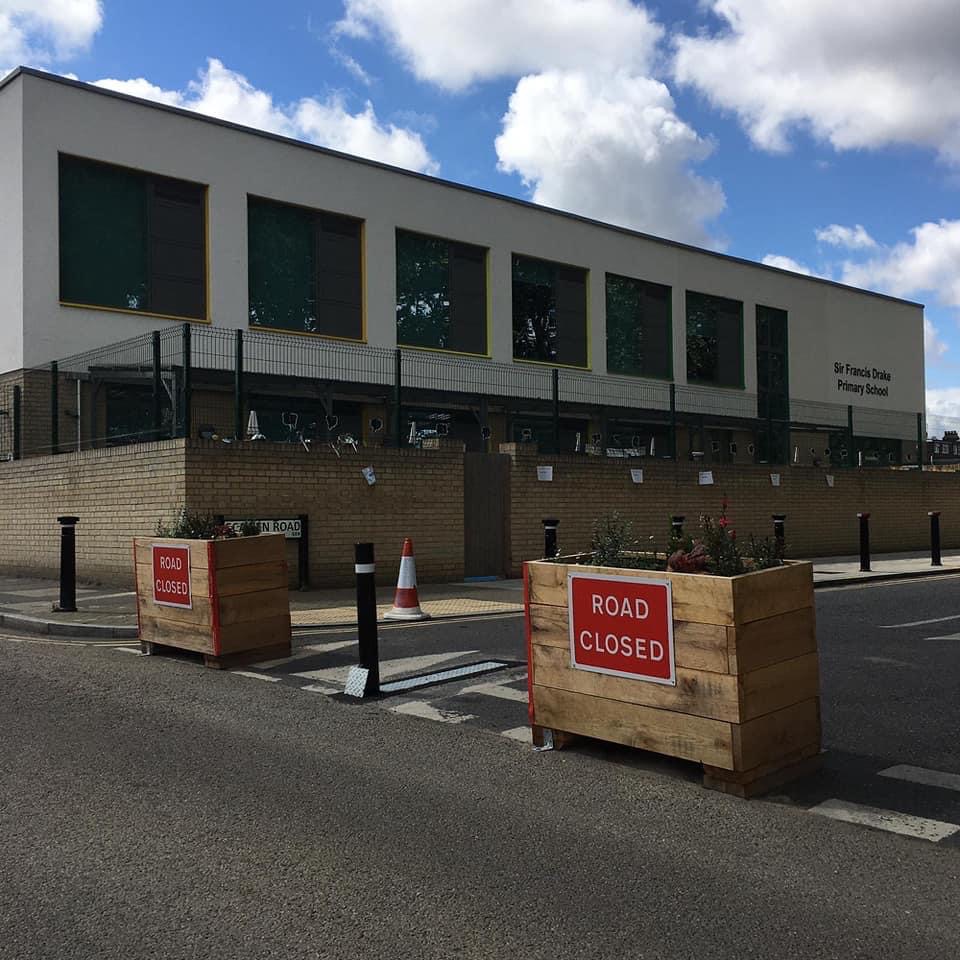Modal filters
Modal filters create a low traffic environment by restricting access to through-traffic but allowing walking and cycling on individual streets or areas, and planters or bollards are often used to block traffic from entering. These roads are still accessible by car, but through-traffic in residential areas is reduced. The image shows an example of what a modal filter looks like.
We use modal filters in the borough to create quiet routes which enable active travel and help improve local air quality.
This page provides information on proposals for modal filters to be used in:
- West Greenwich
- Westcombe Park and Maze Hill
- Woolwich
- Horn Park and Weigall Road Area
We recently adopted a new transport strategy. This sets out our policy of using an evidence-led approach to identify areas which would most benefit from through-traffic reduction schemes, such as low traffic neighbourhoods. We are in the process of undertaking the analysis required for this. We will share more information when we have it.
West Greenwich Low Traffic Neighbourhood
A low traffic neighbourhood (LTN) was on trial in West Greenwich in 2020 to try to reduce traffic, improve air quality and improve safety for pedestrians and cyclists in the area.
The Cabinet Member for Environment, Sustainability & Transport took the decision to approve the removal of the West Greenwich LTN and consider options for an alternative LTN traffic scheme for West Greenwich by authorising Council officers to begin developing an alternative scheme in consultation with the Cabinet Member.
Monitoring data and feedback from local residents has raised concerns regarding the impact of transferring local traffic to other areas and the issues identified in the EQIA including how it could affect people with disabilities. Any future proposals will be subject to further consultation with local residents.
Restrictions that were in place before the experimental LTN were returned into force again when works to remove the current traffic measures were completed, including HGV restrictions and reinstatement of the one-way restrictions.
Decision report for West Greenwich Low Traffic Neighbourhood
Consultation for West Greenwich Low Traffic Neighbourhood (closed)
Westcombe Park and Maze Hill Area Low Traffic Neighbourhood
The Cabinet Member for Environment, Sustainability and Transport took the decision not to implement the scheme as outlined in the consultation.
The council had consulted on proposals to introduce closures to stop cars from taking shortcuts through residential roads at strategic locations along the railway line - Maze Hill, Vanbrugh Hill, Halstow Road, Westcombe Hill.
The majority of respondents within the area had disagreed or strongly disagreed with the proposals.
The council will now explore the scope for alternative traffic calming measures on Maze Hill, Vanbrugh Hill and Westcombe Hill instead, to address specific issues on those roads identified during the consultation, including HGV traffic.
Following feedback from some residents, improvements have been made in Vanbrugh Hill: extra regulatory signs, warning signs and road markings to deter overtaking, as well as an increased amount of 20mph warning signs/road markings to reinforce the speed limit.
We are also exploring the option to provide a formal pedestrian crossing in Vanbrugh Hill, to provide a safe crossing point for people walking - as well as reducing the speed of vehicles.
We have already been improving pavements to make it easier for disabled people and buggy users to get around by installing tactile crossings, removing unnecessary street clutter and narrowing junctions to slow drivers down.
Decision report for Westcombe Park and Maze Hill
Consultation for Westcombe Park and Maze Hill (closed)
Woolwich area one-way system
The council consulted on proposals for a one-way system in Woolwich to stop people from taking shortcuts through residential roads by making part of Sandy Hill Road one way from the junction with Crescent Road to the junction with Brookhill Road.
We listened to feedback during the course of the consultation and considered all of that feedback alongside other information we have collected.
The majority of respondents within the area were supportive of the proposals.
We recently adopted a new transport strategy. This sets out our policy of using an evidence-led approach to identify areas which would most benefit from through-traffic reduction schemes. We are in the process of undertaking the analysis required for this. This scheme will be considered further as part of that analysis.
Decision report for the Woolwich area one-way system
Consultation for the Woolwich area one-way system (closed)
Horn Park and Weigall Road Area Low Traffic Neighbourhood
The Leader took the decision not to implement the scheme as outlined in the initial engagement, and to continue the monitoring of traffic levels in the area.
The council had consulted on proposals to introduce closures to stop cars from taking shortcuts through residential roads at strategic locations - Weigall Road, Abergeldie Road and Westhorne Avenue.
The majority of respondents within the area had disagreed or strongly disagreed with the proposals.
Monitoring traffic levels in the area will allow the Council to assess the impact of external changes on streets in the area, in particular, the effect of changes to the road network in neighbouring areas (including in the London Borough of Lewisham), and changes to travel patterns due to the pandemic and subsequent recovery. Any traffic management that might be considered in the future, as a result of monitoring, would be brought forward as a new proposal.
Decision report for Horn Park and Weigall Road
Consultation for Horn Park and Weigall Road (closed)
Using modal filters to create a cycle route between Plumstead and Abbey Wood
A quiet, safe 2km cycle route has been created between Plumstead and Abbey Wood using modal filters. The route is a parallel alternative to Plumstead High Street.
We have delivered this route upgrading existing filters along quiet back streets, helping cyclists travel between Plumstead High Street and Abbey Wood station. This was delivered as part of the Department for Transport’s Emergency Active Travel Fund in Summer 2020.
